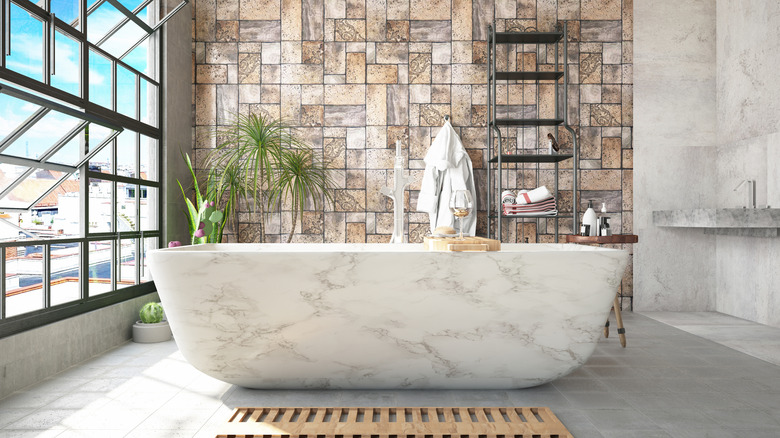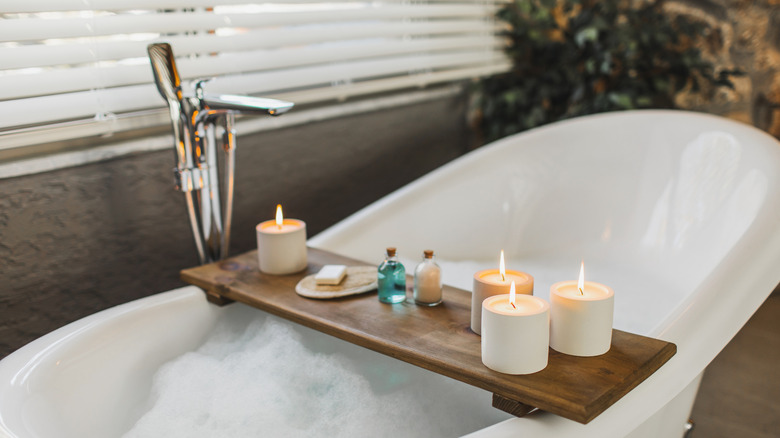Upgrading To A Freestanding Tub? You May Want To Consider This Alternative Instead
When the time comes to replace that dated shower-tub combination in your bathroom, it's easy to get option paralysis. From whirlpool jacuzzi tubs to charming, clawfoot tubs that make a statement, there's a sea of options to wade through while planning your bathroom renovation. One awe-inspiring option on many homeowners' wish lists is a freestanding tub taking center stage in the primary bathroom. Freestanding soaking tubs are trendy, thanks to their sleek design and opulent aesthetics, but they may not be the best fit for every home.
Freestanding tubs often become the focal point of modern bathrooms since they stand independently and aren't confined to the wall. They also eliminate some of the high-maintenance downsides of having a shower-tub combo — that includes more surface area to clean and messy caulk to replace. But not all bathrooms have enough space to accommodate a freestanding tub, which takes up valuable real estate in the center of the room.
One popular alternative to the freestanding tub is a chic back-to-wall bathtub. By positioning the soaking tub flush against the wall, you can enjoy all the luxuries of a freestanding bathtub without sacrificing as much space in the middle of the room. There are many other reasons why you might want to consider a back-to-wall bathtub in lieu of a freestanding tub, but it's important to look at the potential downsides as well.
Back-to-wall bathtubs are sophisticated space savers
Back-to-wall bathtubs are better suited for smaller bathrooms than freestanding tubs, which can dominate or obstruct the space if you don't have a massive bathroom. If you're looking to make your small bathroom seem bigger, a back-to-wall bathtub is definitely the way to go. You'll have a better traffic flow in a compact bathroom space with the bathtub hugging a wall than you would with it floating in the middle. This design may also leave more space for shelves, cabinets, and other freestanding furniture pieces in your bathroom.
Another common gripe with freestanding tubs is the lack of surrounding shelves or ledges for storage. By choosing a tub that's against the wall, you open up the opportunity to use floating shelves, hanging hooks, or even a sunny windowsill for storage and decor. The nearby wall also offers a bit of a safety net, giving you a way to support yourself as you get in and out of the tub. You can install safety bars on the wall if needed for family members who need extra support.
A tub installed close to the wall is easier to clean and maintain compared to freestanding tubs, which have more gaps that can get grimy over time. But one of the biggest appeals to back-to-wall tubs is that, on average, they are more affordable than freestanding bathtubs. They're easier to install, since they are closer in proximity to plumbing lines, including the water supply and drainage. Since the installation is more straightforward, you could save money on labor costs. The tub itself requires fewer finishing materials than freestanding tubs since one side is against the wall, which can reduce the price of purchasing the tub.
Back-to-wall bathtubs aren't perfect for every home
While back-to-wall tubs are a practical and low-maintenance alternative, they're not for everyone. One downside to back-to-wall tubs is they can't be moved if you feel the need to rearrange your bathroom's floor plan. They also offer less flexibility than freestanding tubs when it comes to placement and room design because you'll need a large wall space — you may end up putting your back-to-wall tub where your existing shower and tub combo is. If you want to change up the layout, it can be more challenging. Back-to-wall bathtubs also require the extra step of waterproofing more nearby surfaces and tiling to avoid water damage.
Finally, back-to-wall bathtubs don't have the same wow factor as freestanding tubs, which truly are a statement piece and command a room. They evoke a sense of luxury and indulgence. Back-to-wall tubs come in a range of styles to fit your bathroom's aesthetic, but they often aren't quite as much of a standout feature as a freestanding tub. If you have ample amounts of square footage in your bathroom, a freestanding tub could be worth the extra space it takes up. Overall, both back-to-wall and freestanding bathtubs can elevate your bathroom and become a welcoming respite at the end of a long day. It all comes down to your needs and the available space in your bathroom.


